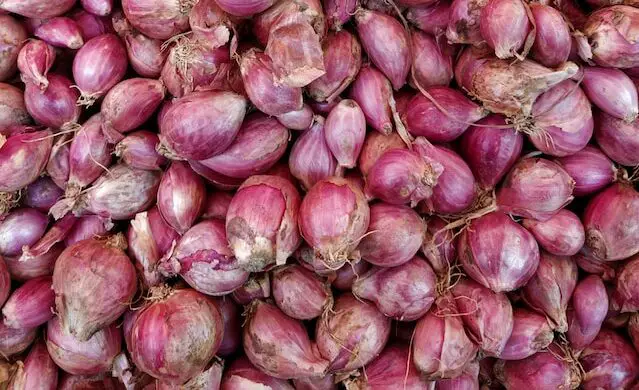The difference between shallots and onions is that shallots have a more delicate flavor with less of a bite than their onion counterparts. Shallots come in two varieties, red and yellow, both of which are great for adding a mild sweetness or depth to dishes. Onions can vary in terms of taste depending on the variety, but generally offer a sharper, pungent taste when eaten raw. Both ingredients provide an essential base for many recipes so it’s important to know the difference between them when cooking.
What are shallots?
(Photo by Dhivyaa Naraayani on Unsplash )

Shallots are a type of onion that is known for its small, elongated shape and its light brown skin. Unlike onions, shallots grow in clusters and have a sweeter, milder flavor. When cooked, shallots become golden brown and slightly crispy. While shallots can be used in many of the same dishes as onions, they are often used in finer recipes where their sweetness can enhance the flavor of the dish. sautéing, roasting, and grilling.
What are onions?
(Photo by ABHISHEK HAJARE on Unsplash )

Onions are a type of vegetable that are commonly used in cooking. They are usually white or yellow in color, and have a strong, distinct flavor. Onions can be eaten raw, cooked, or pickled. They are a versatile ingredient that can be used in many different dishes.
The difference in taste
The difference in taste between shallots and onions is pretty subtle. Shallots are a bit sweeter and milder than onions, while still having that characteristic pungent flavor. They’re also a bit more delicate, so they can be used in raw preparations like salads. If you’re looking for a shallot substitute in a recipe, you can use onion, but it won’t be quite the same.
The difference in nutrition
There are a few key nutritional differences between shallots and onions. For one, shallots are a good source of vitamin C, while onions are not. Shallots also contain more fiber than onions. Additionally, shallots have a lower calorie and carbohydrate content than onions. Finally, shallots contain more antioxidants than onions.
How to use shallots and onions in cooking
Shallots and onions are flavorful and aromatic vegetables that can be used in a wide range of dishes. Here are some tips for using shallots and onions in cooking:
- Sautéing: Both shallots and onions can be sautéed in oil or butter to add flavor to a dish. Sauté them until they are translucent and fragrant, but not browned.
- Caramelizing: You can also caramelize onions and shallots to bring out their sweetness. Slice them thinly and cook them over low heat with some oil or butter until they are golden brown and soft.
- Roasting: Roasting onions and shallots can also be a delicious way to use them in cooking. Cut them into wedges or chunks, drizzle with some oil and seasonings, and roast in the oven until they are tender and caramelized.
- Grilling: Onions and shallots can be sliced and grilled until they are charred and soft. This is a great way to add flavor to burgers, sandwiches, or as a side dish.
- Adding to sauces: Onions and shallots can be finely chopped and added to sauces, soups, stews, and marinades to add depth of flavor.
- Pickling: Shallots can be pickled in vinegar and used as a topping for sandwiches, salads, or as a garnish for meats and seafood.
Overall, shallots and onions are versatile ingredients that can be used in many different ways to add flavor and complexity to your dishes. Experiment with different cooking methods and combinations of herbs and spices to discover your favorite flavor combinations.
Recipes that include shallots or onions
There are many recipes that include either shallots or onions as ingredients. Some examples of dishes that include shallots are French onion soup, green beans with shallots, roasted Brussels sprouts with shallots, and baked salmon with shallot-Dijon sauce. On the other hand, recipes that include onions can range from the classic American dish of onion rings to more exotic fare such as chicken curry with onions or Italian pasta with caramelized onions. No matter what your taste preferences are, there’s sure to be a recipe out there that includes either shallots or onions (or both!) as an ingredient.
The health benefits of shallots and onions
Shallots and onions are both members of the allium family of vegetables and are known for their pungent flavors and distinct aroma. They are also packed with nutrients and have a variety of health benefits. Here are some of the health benefits of shallots and onions:
- Rich in antioxidants: Both shallots and onions are high in antioxidants, which help protect your cells from damage caused by free radicals.
- Immune-boosting properties: Shallots and onions contain compounds that have immune-boosting properties, which can help protect against infections and diseases.
- Anti-inflammatory effects: Some compounds found in shallots and onions have anti-inflammatory effects, which can help reduce inflammation in the body and may help prevent chronic diseases.
- Heart health: Shallots and onions are low in calories and high in fiber, which can help support heart health by lowering cholesterol levels and reducing the risk of heart disease.
- Blood sugar control: Some compounds found in shallots and onions may help regulate blood sugar levels, which can be helpful for people with diabetes.
- Cancer prevention: Some studies suggest that the compounds found in shallots and onions may have anti-cancer properties and may help prevent the growth and spread of cancer cells.
Overall, shallots and onions are a healthy addition to any diet. They are versatile, delicious, and packed with nutrients and health benefits. Incorporate them into your meals for a flavorful and nutritious boost.
Why do chefs use shallots instead of onions?
Chefs often use shallots instead of onions because shallots have a milder, sweeter flavor that can enhance the taste of a dish without overpowering other ingredients. Shallots also have a more delicate texture than onions, which makes them ideal for dishes where a finer texture is desired.
Additionally, shallots have a higher concentration of certain compounds, such as sulfur and phenolic compounds, which can contribute to their unique flavor and aroma. These compounds can also provide health benefits, such as antioxidant and anti-inflammatory effects.
Shallots also have a shorter growing season than onions, which can make them more expensive and harder to find. This can add to their appeal and exclusivity in certain dishes.
Overall, shallots and onions are both versatile ingredients that can be used in a variety of dishes. Chefs may choose to use shallots over onions for their unique flavor, texture, and health benefits, as well as their culinary appeal.
Featured Image By – vivek sharma on Unsplash








